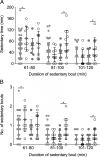Physical Activity and Sedentary Time: Association with Metabolic Health and Liver Fat
- PMID: 30694971
- PMCID: PMC6542688
- DOI: 10.1249/MSS.0000000000001901
Physical Activity and Sedentary Time: Association with Metabolic Health and Liver Fat
Abstract
Introduction/purpose: To investigate whether (a) lower levels of daily physical activity (PA) and greater sedentary time accounted for contrasting metabolic phenotypes (higher liver fat/presence of metabolic syndrome [METS+] vs lower liver fat/absence of metabolic syndrome [METS-]) in individuals of similar body mass index and (b) the association of sedentary time on metabolic health and liver fat.
Methods: Ninety-eight habitually active participants (53 female, 45 male; age, 39 ± 13 yr; body mass index 26.9 ± 5.1 kg·m), underwent assessments of PA (SenseWear armband; wear time ~98%), cardiorespiratory fitness (V˙O2 peak), body composition (magnetic resonance imaging and magnetic resonance spectroscopy) and multiorgan insulin sensitivity (oral glucose tolerance test). We undertook a) cross-sectional analysis comparing four groups: nonobese or obese, with and without metabolic syndrome (METS+ vs METS-) and b) univariate and multivariate regression for sedentary time and other levels of PA in relation to liver fat.
Results: Light, moderate, and vigorous PA did not account for differences in metabolic health between individuals, whether nonobese or obese, although METS+ individuals were more sedentary, with a higher number, and prolonged bouts (~1-2 h). Overall, sedentary time, average daily METS and V˙O2 peak were each independently associated with liver fat percentage. Each additional hour of daily sedentary time was associated with a 1.15% (95% confidence interval, 1.14%-1.50%) higher liver fat content.
Conclusions: Greater sedentary time, independent of other levels of PA, is associated with being metabolically unhealthy; even in habitually active people, lesser sedentary time, and higher cardiorespiratory fitness and average daily METS is associated with lower liver fat.
Figures



References
-
- Henson J, Yates T, Biddle SJ, et al. Associations of objectively measured sedentary behaviour and physical activity with markers of cardiometabolic health. Diabetologia. 2013;56(5):1012–20. - PubMed
-
- Romero-Gómez M, Zelber-Sagi S, Trenell M. Review: treatment of NAFLD with diet, physical activity and exercise. J Hepatol. 2017;67:829–46. - PubMed

